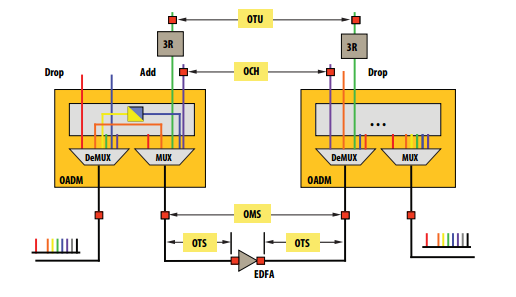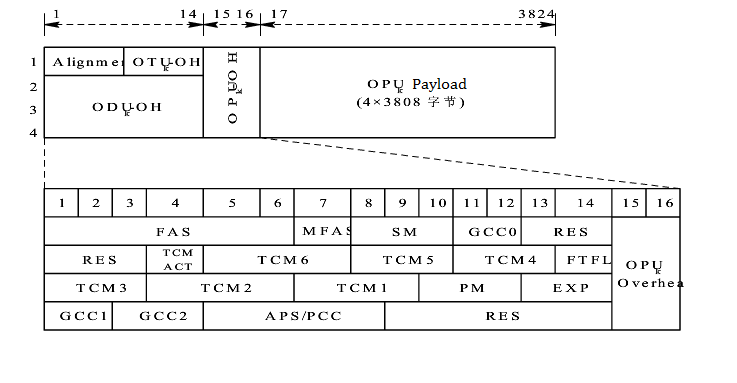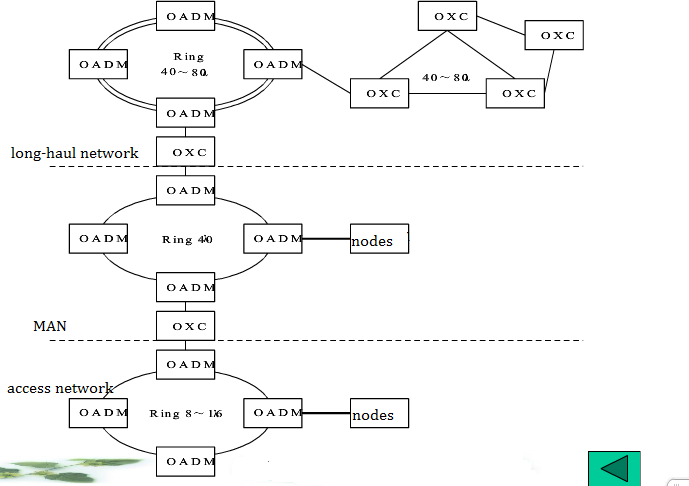OTN Tutorial: Introduction
As we known, the core of most current operator networks is the asynchronous digital hierarchy/ synchronous optical network (SDH/SONET), which has always offered good fault management, performance monitoring, predictable latency, a protection mechanism and, of course, synchronization. However, nowadays a significant rise in bandwidth demand associated with video services and an increasing use of local area networking (LAN) and storage area networking (SAN) drive the need for optical transport network (OTN), which is the new-generation backbone transmission network based on WDM techniques with the dual advantages of SDH/SONET and WDM and the ability of meeting the requirements of various services, as a transport technology for point-to-point transmission application in core/long-haul networks and for aggregation/switching applications in metro networks. As the optimal choice for developing the transport network, OTN is playing a more and more important role in the transport network. This article is written to give you a sound understanding of OTN tutorial through introducing its structures and application.
OTN Tutorial: The Hierarchical Structure
An OTN introduces three main sublayers: an optical channel (OCH), an optical multiplexing section (OMS), an optical transmission section (OTS). The hierarchical structure is shown in Figure 1. The OCH layer provides an end-to-end connection in a unit of wavelength for various services’ signals from the electric layer. What the OMS layer accomplishes is to multiplex and demultiplex lots of signals from the OCH layer. The OTS layer deals with the physical transmission problems of optical signals in specifically optical media. A client-server model is applied between sublayers of OTN. Each sublayer offers well-defined services to its client layers and each sublayer has its own layer-management functions including fault, performance, and configuration management. An OCH layer consists of many OMS layers and an OMS layer is made up of numerous OTS layers. So if the bottom layer breaks down, it certainly affected the correspondingly upper layers.
Figure 1: The hierarchical structure of OTN
OTN Tutorial: The Frame Structure
Speaking to the frame structure of OTN, we should first refers to the digital wrapper technology. OTN uses the digital wrapper technology to wrap each wavelength into a digital envelope consisting of a overhead section, a forward error correction (FEC) section and a payload section (Figure 2). The overhead section lies in the head of a digital envelope, which is used to load the overhead bytes. With those bytes, OTN can execute the networking management functions through network transmission. The FEC part is located in the tail, which is applied to load the FEC codes and partly perform the detection and correction of errors. By minimizing the errors, FEC plays a key role in expanding distance between optical sections and increasing transmission rate. Between the header and tailer is the payload section, which is employed to load all kinds of networking protocol data packages without changing them.
Figure 2: The digital envelope
A frame in OTN is called an optical channel transport unit (OTU), which is brought into being by means of the digital wrapper technology adding the overhead section and the FEC section into client signals. There are three rates of OTU-k (k=1,2,3): 2.5Gb/s, 10Gb/s and 40Gb/s in standard G.709. An OTU-k is composed of four parts: an optical channel payload unit (OPUK), an optical channel data unit (ODUK), an optical channel transport unit (OTUK) and an FEC. An OPUK section is made up of a overhead and a payload. The overhead part contains the adapted information used for supporting specific clients and each client has his/her own overhead structure, while the payload part includes client signals adopting specific mapping technology. An ODUK section offers cascade connection monitoring and end-to-end channel monitoring, including numerous overhead fields such as path performance monitoring (PM), tandem connection monitoring (TCM), automatic protection switching (APS), protection communication control channel (PCC), etc. An OTUK part is mainly applied to monitor the state of transmission signals between regenerative nodes. Asis mentioned above, the FEC part is applied to load the FEC codes and partly perform the detection and correction of errors to minimize emerging errors. The frame structure is as below (Figure 3).
Figure 3: The frame structure of OTN
OTN Tutorial: The Topological Structure
The topological structure of OTN includes the logical structure describing the routes of information flow in network and the physical structure describing the practical distribution and the connection ways of nodes or fiber media used to connect nodes. The logical structure is divided into the dual-loop structure and the daisy-chaining structure, and the former is the optimal choice because the dual-loop structure provide the better recovering ability of systems in the breakdown situation to guarantee the high-quality service and offer an reliable and effective network for clients. The physical structure includes point-to-point configuration (Figure 4), star configuration (Figure 5), ring configuration (Figure 6) and linear configuration (Figure 7), which is relatively simple and follow standard installing convention. These physically topological structures can be flexibly and collocationally used according to client needs. To guarantee the high reliability and perform the flexible bandwidth management, the ring configuration is extensively applied in the core/long-haul network , the metropolitan area network (MAN) and the access network, as is shown in Figure 8. In the whole ring configuration, we will uses such products as optical add-drop multiplexer (OADM), optical cross connection (OXC), etc.
Figure 4: The point-to-point configuration
Figure 5: The star configuration
Figure 6: The ring configuration
Figure 7: The linear configuration
Figure 8:The ring configuration in long-haul network, MAN and access network
OTN Tutorial: The Application
Comprehensively considering the hierarchical relationships of existing transport network, the distributing features of the transmission particles and the different states of OTN devices, OTN is extensively applied in the core layer of the long-haul transmission network and the MAN. Nowadays the core MAN facing the situation of digital services soaring, but the IP digital network fails to meet these services’ requirements owing to a lack of sufficient protection and recovery abilities. The photoelectric cross device of OTN could be used to solve the current problem of the MAN. Introducing OTN in the core MAN, we can offer plenty of bandwidth resources for the IP digital network and provide the carrier-class protection for digital services to significantly the service quality of digital services. At the same time, we also save the interface resources of router to low the requirement for router capacity and offer the protection and recovery of mesh network. The long-haul transmission network is to perform the transmission of services without refering to the complicated service scheduling and crossing. Adopted in the long-haul network, OTN can greatly facilitate the fault monitoring and operating management of systems with its rich overhead bytes. Being able to transparently transmit signals, OTN enables routers to use 10GE digital interfaces instead of expensive POS interfaces when facing lots of soaring digital services in the long-haul network. What’s more, OTN contributes a lot to achieving all-sided optical crossing in the future with the ability to combine itself with intelligent surfaces.
Conclusion
As the optimal choice for the technological developmemt of the transmission network, it is predictable that OTN will be extensively used in the near future to become the preferred transmission network for operators and clients. I hope you can get a further understanding of OTN tutorial after reading this article. If you want know more about OTN product, please visit FS.COM, which provides a comprehensive line of networking devices including patch panel, network switch and so on.
Related Articles:
What Is OTN — Optical Transport Network?
Difference Between SONET/SDH and DWDM







